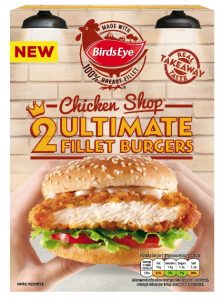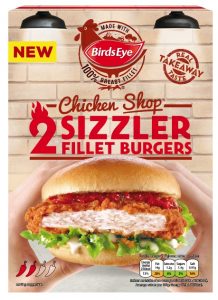Poultry products have long been a staple favorite for many households in the United Kingdom, and its popularity shows no sign of abating. In fact, according to Neilsen Scantrak, the demand for frozen chicken continues to grow, with the category reportedly up 6.6% value growth on average every year since 2017.
The outbreak of African swine fever (ASF) in China last year has seen the poultry sector grow due to demand for alternative protein sources. Increased import levels were recorded in 2019, with Chinese imports of frozen and non-frozen poultry advancing 40% (+42,000 tons) year-on-year in the first quarter.
“Globally, the increased demand from China may help support prices in the international poultry market,” said Duncan Wyatt, lead analyst of market intelligence for the Agriculture and Horticulture Development Board (AHDB). “Rising import demand is also expected from other key importers, including Japan, Mexico and the EU. Global exports are therefore forecast to grow 3% overall, to 11.6 million tons. However, developments in global trade restrictions will also be important, and Avian Influenza remains a concern.”
The United States Department of Agriculture (USDA) predicted a 3% uptick in the world’s chicken meat production in 2019, to a record 98.4 million tons. Growing Chinese output (+8%) primarily supports this. More modest increases are expected from other producers, including Brazil (+2%), the EU (+2%) and the US (1%), primarily supporting rising domestic consumption in these regions.
Production of poultry in the United Kingdom totaled 1.4 million tons during the first nine months of 2018, up 5% (61,000 tons) year on year. Much of this increase can be attributed to broiler and turkey production output of +4% (50,800 tons) and +9% (9,200 tons), respectively.
The number of broiler chickens slaughtered has increased 4% (30.8 million) over previous year levels to 810 million birds. The figure for turkeys slaughtered has risen by around half a million.
UK exports of chicken grew by 18% (47,100 tons) in 2017, to 309,900 tons. Over 95% of UK imports of fresh/frozen chicken meat come from other EU countries, while just over three quarters of exports are destined for the EU. In 2018 chicken performed strongly in the supermarkets, somewhat bucking the trend of other proteins. In the 12 weeks ending 25 February there were 18% more promotions on chicken, which has helped support an increase in volume sold.
Foodservice Trends
When it comes to new product development within the foodservice sector a key trend seems to be health, with the demand for gluten-free chicken products significantly increasing.
According to Northamptonshire, England-based frozen food distributor Central Foods, sales of its Golden Valley Foods range of gluten-free poultry products for the foodservice sector increased by an average of 155% during 2019 compared to the previous year. The best seller – gluten-free plain breaded chicken goujons – advanced by almost 200%.

“Gluten-free awareness has grown considerably over the past few years,” said Gordon Lauder, managing director of the company. “According to Coeliac UK, around one in 100 people are believed to have Coeliac Disease, an autoimmune disease condition caused by an abnormal reaction to gluten. Alongside this, there are others who actively decide to avoid gluten as a lifestyle choice. As a leading frozen food distributor in the UK, we have certainly seen a significant increase in demand for free-from items.”
Quality is equally important to consumers. In fact, according to research by Mintel, 45% of affluent Brits visited chicken shops in 2019 and 72% of them said this was because burger and chicken restaurants are offering more healthy options than a year ago. Consumers are looking for products of consistent quality made of prime breast meat and perhaps emblazoned with accreditations such as Crossed Grain to reinforce the reassurance of a product’s integrity.

“There’s strong appetite for the products because caterers and consumers are willing to pay more for quality, consistency and flavor,” said Lauder.
Takeaway and Fakeaway on the Rise
The growth in the home delivery market by organizations such as Deliveroo and Uber Eats has seen a surge in takeaway-style food, with almost four in ten (37%) consumers ordering more food for home delivery from burger and chicken outlets and restaurants than they did a year ago, when the figure was 25%, according to the Mintel survey.
At the same time, however, economic uncertainty among Brits in the current Brexit environment has increased occasions for “fakeaway,” or takeaway-style food, being prepared and consumed at home. As a result big players such as Birds Eye have introduced a range of frozen “Chicken Shop” products to meet the demand.

Birds Eye’s new Chicken Fillet Burgers were launched this month as part of its takeaway-style Chicken Shop range and includes two different SKUs: the Ultimate Fillet Burger and the Sizzler Fillet Burger, available now at ASDA stores for £3.
The Sizzler Fillet Burger has a spicy coating and is ideal for those looking a meal to pack a punch, while the Ultimate Fillet Burger has a southern fried coating made from a proprietary Birds Eye recipe, which is formulated to appeal to shoppers looking for the full takeaway experience.
“Chicken is as popular as it ever has been, particularly when cooked from frozen at home as consumers replicate the full takeaway experience,” said James McComas, brand manager for Birds Eye Chicken. “Shoppers want great tasting, high quality chicken products and launch of the Chicken Shop range last year proved that our chicken is as delicious as normal takeaway – if not better!”

All the major retailers are following suit, with Tesco offering the Sfc Boneless Chicken Bucket; Lidl selling a line of seasoned, coated chicken products that includes Southern Fried Chicken Pops under the Red Hen brand (see photo at top of feature); Morrisons menuing Hot & Spicy Chicken Strips; and Iceland presenting Southern Chicken Popsters.
Street-style food’s popularity shows no sign of diminishing, particularly when it comes to poultry. UK consumers are looking for healthier versions of their favorite takeaway options, and as one of the leanest meat protein sources around it seems that chicken is the clear winner. – Reported by Sarah Welsh






